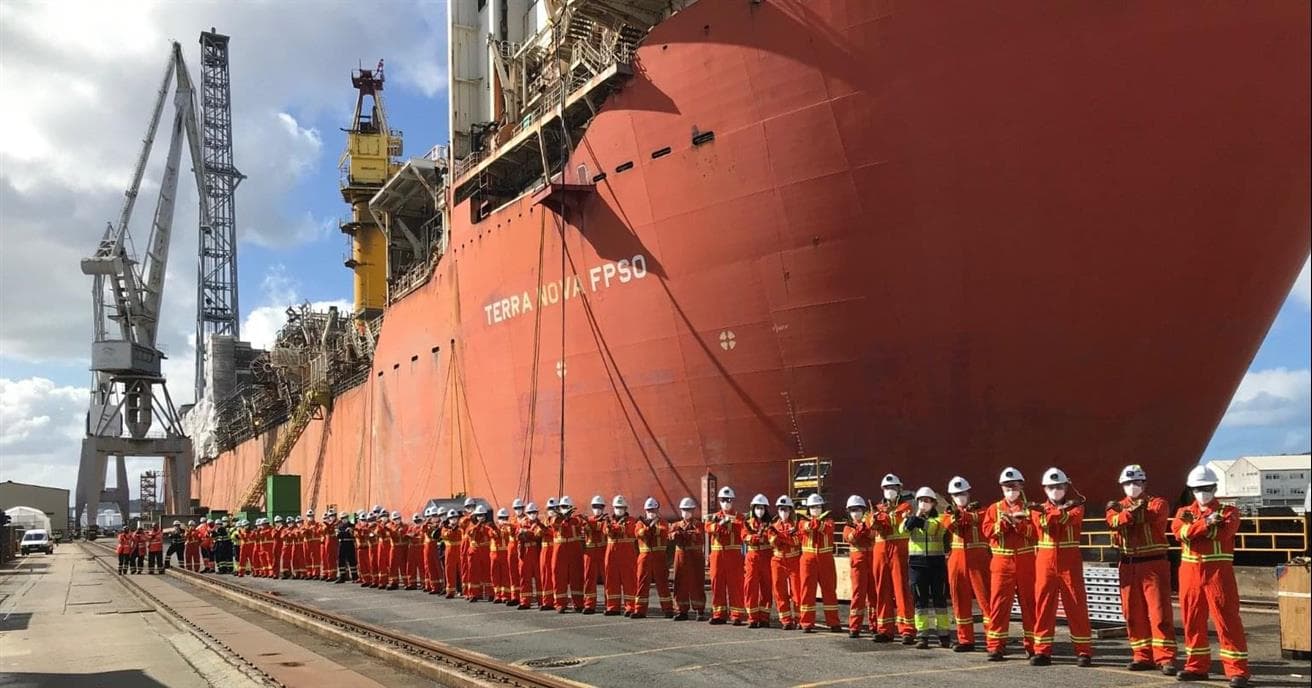That’s exactly what the Terra Nova Floating Production Storage and Offloading (FPSO) vessel did in December, when she sailed from the coast of Newfoundland and Labrador to Ferrol, Spain.
The FPSO and about 150 Suncor employees have been in Ferrol for more than eight months, working with local vendors and craftspeople on the Asset Life Extension (ALE) project. This project is anticipated to add another 10 years and 70 million barrels of oil to the FPSO’s production capacity.
“This project is about more than extending the production life of the Terra Nova field,” explains Brent Miller, Suncor’s VP of the East Coast. “The work being done on the project will help secure Canada’s East Coast energy future, strengthen the province’s economy and has provided local jobs for Newfoundland and Labrador.”
The external hull work is done and the FPSO has been moved from the shipyard’s drydock to quayside to complete the remaining work. The focus now is on the “fabric maintenance,” such as rust removal, painting, new insulation and new heat tracing.
“It’s a lot of work and the teams are very committed,” says Kirk Goobie, GM Operations, Life Extension Project. “Everyone—Suncor employees in Spain, the teams preparing for restart back in Newfoundland, contractors and craftspeople—are working well together with a common goal.”
Under the sea
While the ship is getting work done in Spain, back home off the shores of Newfoundland and Labrador, crews are busy upgrading equipment on the sea floor.
“The biggest component of the ALE project is the work being done to the ship in Spain, but we also have divers working underwater 350 kilometers offshore of Newfoundland and Labrador,” adds Kirk.
Tucked away in saturation chambers that maintain air pressure that coincides with 100 metres below the ocean’s surface, divers on the dive support vessel (DSV), the Seven Falcon, wait until their next six-hour shift.
Each day, a trio of divers exit their pressurized chambers, where they are constantly monitored by a support team that includes medical staff, and climb into another chamber, called a diving bell, that lowers them to the ocean floor. Two divers exit the diving bell and swim to the equipment to do maintenance work and complex tasks on the equipment that attaches to the FPSO from the floor of the Atlantic Ocean. One diver remains in the diving bell as an emergency backup. Once again, the divers are closely monitored by the dive support staff on the DSV.
“It’s pretty dark down there,” explains Geoff Redfern, Project Manager – Subsea, Exploration and Production and In Situ. “Many of the saturation divers are Canadian—we even had a couple of divers from Newfoundland. There’s a documentary on saturation diving called Last Breath that tells the story of a diver doing similar work at similar depths as the divers working on the Terra Nova field.”
One of the largest replacement tasks taking place under the sea is upgrading the nine mooring legs that anchor the ship to the underwater drilling system. Since the subsea work began in April, two million kilograms of mooring chain has been replaced with new chain that weighs about 450 kilograms per metre.
"There’s a real sense of pride among those working on the Terra Nova ALE project,” says Kirk. “There are a few people who delayed their retirement until after the ship is back and in production, just to see this project through to the end.”
The subsea work is expected to be complete by mid-August. The Terra Nova FPSO, her crew and the employees are expected back in home waters by the end of 2022, when the FPSO is scheduled to be back in production.




